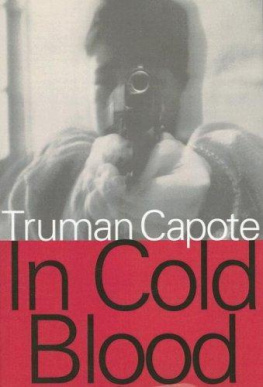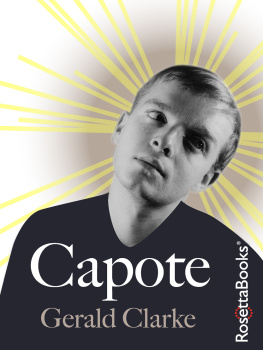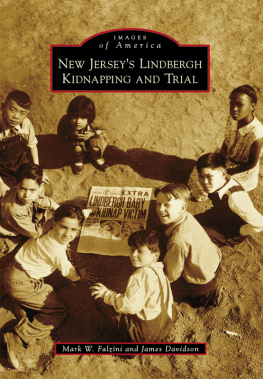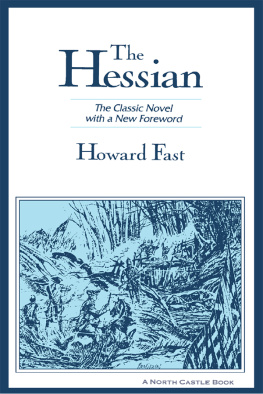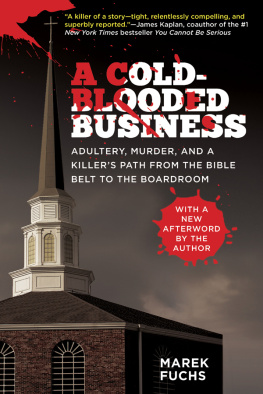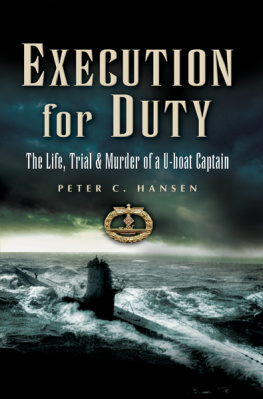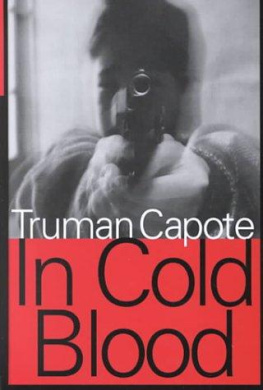I N C OLD B LOOD
A TRUE ACCOUNT OF A MULTIPLE MURDER
AND ITS CONSEQUENCES
T RUMAN C APOTE
C ONTENTS
TRUMAN CAPOTE
Truman Capote was born Truman Streckfus Persons on September 30, 1924, in New Orleans. His early years were affected by an unsettled family life. He was turned over to the care of his mothers family in Monroeville, Alabama; his father was imprisoned for fraud; his parents divorced and then fought a bitter custody battle over Truman. Eventually he moved to New York City to live with his mother and her second husband, a Cuban businessman whose name he adopted. The young Capote got a job as a copyboy at The New Yorker in the early forties, but was fired for inadvertently offending Robert Frost. The publication of his early stories in Harpers Bazaar established his literary reputation when he was in his twenties, and his novels Other Voices, Other Rooms (1948), a gothic coming-of-age story that Capote described as an attempt to exorcise demons, and The Grass Harp (1951), a gentler fantasy rooted in his Alabama years, consolidated his precocious fame.
From the start of his career Capote associated himself with a wide range of writers and artists, high-society figures, and international celebrities, gaining frequent media attention for his exuberant social life. He collected his stories in A Tree of Night (1949) and published the novella Breakfast at Tiffanys (1958), but devoted his energies increasingly to the stageadapting The Grass Harp into a play and writing the musical House of Flowers (1954)and to journalism, of which the earliest examples were Local Color (1950) and The Muses Are Heard (1956). He made a brief foray into the movies to write the screenplay for John Hustons Beat the Devil (1954).
Capotes interest in the murder of a family in Kansas led to the prolonged investigation that provided the basis for In Cold Blood (1966), his most successful and acclaimed book. By treating a real event with fictional techniques, Capote intended to create a new synthesis: something both immaculately factual and a work of art. However its genre was defined, from the moment it began to appear in serialized form in The New Yorker the book exerted a fascination among a wider readership than Capotes writing had ever attracted before. The abundantly publicized masked ball at the Plaza Hotel with which he celebrated the completion of In Cold Blood was an iconic event of the 1960s, and for a time Capote was a constant presence on television and in magazines, even trying his hand at movie acting in Murder by Death .
He worked for many years on Answered Prayers , an ultimately unfinished novel that was intended to be the distillation of everything he had observed in his life among the rich and famous; an excerpt from it published in Esquire in 1975 appalled many of Capotes wealthy friends for its revelation of intimate secrets, and he found himself excluded from the world he had once dominated. In his later years he published two collections of fiction and essays, The Dogs Bark (1973) and Music for Chameleons (1980). He died on August 25, 1984, after years of problems with drugs and alcohol.
INTRODUCTION
BY BOB COLACELLO
In Cold Blood: A True Account of a Multiple Murder and Its Consequences riveted the nations attention when it was first published as a four-part series in The New Yorker in the fall of 1965 and then in book form by Random House in early 1966. I met Truman Capote several years later. Although Truman and I sometimes spent entire days together, he almost never mentioned the work that had brought him fame and fortune. Occasionally, hed remark that Norman Mailerwho had published his tour de force of novelistic journalism, Armies of the Night , two years after In Cold Blood was receiving far too much praise for exploiting the hybrid form Capote claimed hed invented: the nonfiction novel. (But no matter how hard Mr. Mailer tries, hed say, he will never beat me at my own game.)
Capotes early fiction novels Other Voices, Other Rooms (1948), The Grass Harp (1951), and Breakfast at Tiffanys (1958)were gems of style, charm, and character. But it was only when he turned to journalism in The Muses Are Heard , his acutely observed, amusingly told 1956 report of a tour of Russia by a troupe of American actors performing Porgy and Bess , that his work became modern. He later noted, The Muses Are Heard had set me thinking on a different line altogether: I wanted to produce a journalistic novel, something on a large scale that would have the credibility of fact, the immediacy of film, the depth and freedom of prose and the precision of poetry.
In Cold Blood began with a one-column story, datelined Holcomb, Kansas, on page 39 of The New York Times of November 16, 1959. Its headline read WEALTHY FARMER, 3 OF FAMILY SLAIN. Two weeks later, Capote was on his way to Kansas. He bought a new Dior suit for the trip, says Phyllis Cerf Wagner, the widow of Random House chairman Bennett Cerf. That was the first thing he said to the professor Bennett sent him to at the University of Kansas: Have you ever seen a man in a Dior suit? The professor replied, Not only have I never seen a man in a Dior suit, Ive never seen a woman in a Dior suit. Yet, within a month, the New York City slicker in his Paris wardrobe had succeeded in winning over not only the upstanding citizens of Finney County who re-created the life and personalities of the murdered Clutter family, but also the killers themselves, Dick Hickock and Perry Smith, who poured out their ragtag tales of woe.
Over the next six years, after Hickock and Smith were quickly convicted, sentenced to death, and then granted five stays of execution, Capote grew increasingly close to them. Too close, his friends would say afterward, particularly to Perry Smith, who was almost as short as Truman, and like him, the son of an alcoholic mother who had abandoned him and a father who had disappointed him. Diana Vreeland liked to tell a tale she said Truman had told her: During one of his death row interviews with Smith, Perry grabbed Trumans ballpoint pen and pressed it right against his eyeball, while he held him by the back of his head for something like fifteen minutes. Can you imagine, poor Truman? But it was an act of love you see, as well as an act of terror.
At Hickock and Smiths request, Capote was witness to their execution by hanging on April 14, 1965. Truman told me he always felt guilty about not doing enough for them, about using them, recalls Bianca Jagger. Another friend, C.Z. Guest, says, I begged him not to go to the execution. He felt he should. I think it affected him more than he ever realized. That book took everything out of him. He was so sensitive. He wasnt a tough nut.
By the time I met him, Capote was obsessed with novel-in-progress Answered Prayers which he said, again and again, would be the American equivalent of Prousts Remembrance of Things Past and after a chapter from it, La Cote Basque, 1965, was printed in Esquire in December 1975, with defending himself from the snubs and insults of the rich and powerful friends who found themselves insufficiently fictionalized. But Answered Prayers was never finished. It was during that time that Capote turned to the downtown world of Andy Warhols Factory, where I was then working as editor of Interview magazine. Capotes association with Warhol turned out to be surprisingly productive.
The ever-practical Andy gave Truman a tape recorder so that he could, as Andy put it, Write without writing, and offered to do Trumans portrait for free if hed publish the results in Interview as Conversations with Capote. During 1979, while Interview contributing editor Brigid Berlin sat beside him in his raspberry-lacquered dining room, heaping praise and making sure he kept writing, Truman completed ten pieces for the magazine that purported to be transcripts of tapes but were actually highly structured compositions of recorded and remembered dialogue. At least three of theman extraordinary profile of Marilyn Monroe entitled A Beautiful Child; the hilarious and heartrending A Days Work, in which he followed a Caribbean-born cleaning woman on her Manhattan rounds, and Hand-Carved Coffins, a nonfiction novella about a series of bizarre murders in Nebraskawere as compelling as anything he had previously written. All ten pieces were included in the collection Music for Chameleons (1983), his first book of new work since In Cold Blood , and the last one before his death, at age 59, in 1984.
Next page
